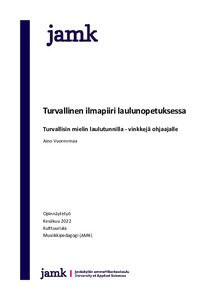Turvallinen ilmapiiri laulunopetuksessa : turvallisin mielin laulutunnilla - vinkkejä ohjaajalle
Vuorenmaa, Aino (2022)
Vuorenmaa, Aino
2022
All rights reserved. This publication is copyrighted. You may download, display and print it for Your own personal use. Commercial use is prohibited.
Julkaisun pysyvä osoite on
https://urn.fi/URN:NBN:fi:amk-2022061317602
https://urn.fi/URN:NBN:fi:amk-2022061317602
Tiivistelmä
Opinnäytetyön tavoitteena oli tutustua turvallisuuden ulottuvuuteen laulunopetuksessa ja sitä kautta kehittää erityisesti rytmimusiikin laulun yksilöopetusta. Työssä keskityttiin ohjaajan rooliin sekä elementteihin,
joihin ohjaaja kykenee vaikuttamaan. Työn avulla selvitettiin, mitkä asiat vaikuttavat oppijan turvallisuudentunteeseen laulutunnilla, ja millaisia taitoja ja tietoja ohjaajalta edellytetään, jotta tämä kykenee luomaan
turvalliselta tuntuvan ilmapiirin tuntitilanteeseen.
Tutkimuksessa käytettiin aineistonkeruumenetelmänä teemahaastattelua eli puolistrukturoitua haastattelua. Haastattelut analysoitiin teemoittelemalla, jonka avulla aineistosta paikannettiin tutkimuskysymyksiin
liittyvä informaatio. Näin saatiin nostettua esille tutkimuksen tavoitteen kannalta oleellisia asioita. Teemat
ovat aineistossa toistuvia asiakokonaisuuksia ja piirteitä. Tietoperustan ja haastatteluiden pohjalta luotiin
ohjaajille suunnattu vinkkilista, johon koottiin konkreettisia neuvoja käytännön työhön.
Tietoperusta ja haastatteluaineisto tukivat hyvin toisiaan, eikä varsinaisia ristiriitoja ole löydettävissä. Tietoperustassa käytetty kirjallisuus ja artikkelit tarjosivat sekä teoreettista tietoa että käytännön esimerkkejä, ja
haastattelussa korostuivat nimenomaan ohjaajan työssä toimivien henkilöiden kokemus, ammattitaito ja
huomiot käytännön näkökulmasta.
Tutkimushaastatteluista oli analysoitavissa kolme pääteemaa, joista kukin jakaantui kolmeen alateemaan.
Pääteemat olivat oppijan kohtaaminen ja vuorovaikutus, ohjaajan pedagogiset taidot sekä rakenteet ja tavoitteet. The aim of the thesis was to get acquainted with the dimension of safety in teaching singing and thereby to
develop individual teaching of rhythm music in particular. The thesis focused on the role of the teacher and
the elements that the teacher is able to influence. The thesis was used to find out which things affect a student’s sense of security during a singing lesson, and what skills and knowledge are required from the
teacher to be able to create a safe atmosphere in the classroom.
The data collection method used in the study was a thematic interview, i.e. a semi-structured interview.
The interviews were analysed by thematic information, which was used to locate information related to the
research questions from the interview material. In this way, issues relevant to the study were appeared.
Themes are recurring issues and features in the interview material. Based on the knowledge base and the
interviews, a list of tips was created for teachers. The tips include advice for practical work.
The knowledge base and the interview material supported each other well, and no actual contradictions
can be found. The literature and articles used in the knowledge base provided both theoretical knowledge
and practical examples. The interviews highlighted the teachers’ experience, professionalism and practical
point of view.
Three main themes appeared form the interviews. Those three main themes divided into three subthemes. The main themes were learners encounter and interaction, teacher’s pedagogical skills and structures and goals.
joihin ohjaaja kykenee vaikuttamaan. Työn avulla selvitettiin, mitkä asiat vaikuttavat oppijan turvallisuudentunteeseen laulutunnilla, ja millaisia taitoja ja tietoja ohjaajalta edellytetään, jotta tämä kykenee luomaan
turvalliselta tuntuvan ilmapiirin tuntitilanteeseen.
Tutkimuksessa käytettiin aineistonkeruumenetelmänä teemahaastattelua eli puolistrukturoitua haastattelua. Haastattelut analysoitiin teemoittelemalla, jonka avulla aineistosta paikannettiin tutkimuskysymyksiin
liittyvä informaatio. Näin saatiin nostettua esille tutkimuksen tavoitteen kannalta oleellisia asioita. Teemat
ovat aineistossa toistuvia asiakokonaisuuksia ja piirteitä. Tietoperustan ja haastatteluiden pohjalta luotiin
ohjaajille suunnattu vinkkilista, johon koottiin konkreettisia neuvoja käytännön työhön.
Tietoperusta ja haastatteluaineisto tukivat hyvin toisiaan, eikä varsinaisia ristiriitoja ole löydettävissä. Tietoperustassa käytetty kirjallisuus ja artikkelit tarjosivat sekä teoreettista tietoa että käytännön esimerkkejä, ja
haastattelussa korostuivat nimenomaan ohjaajan työssä toimivien henkilöiden kokemus, ammattitaito ja
huomiot käytännön näkökulmasta.
Tutkimushaastatteluista oli analysoitavissa kolme pääteemaa, joista kukin jakaantui kolmeen alateemaan.
Pääteemat olivat oppijan kohtaaminen ja vuorovaikutus, ohjaajan pedagogiset taidot sekä rakenteet ja tavoitteet.
develop individual teaching of rhythm music in particular. The thesis focused on the role of the teacher and
the elements that the teacher is able to influence. The thesis was used to find out which things affect a student’s sense of security during a singing lesson, and what skills and knowledge are required from the
teacher to be able to create a safe atmosphere in the classroom.
The data collection method used in the study was a thematic interview, i.e. a semi-structured interview.
The interviews were analysed by thematic information, which was used to locate information related to the
research questions from the interview material. In this way, issues relevant to the study were appeared.
Themes are recurring issues and features in the interview material. Based on the knowledge base and the
interviews, a list of tips was created for teachers. The tips include advice for practical work.
The knowledge base and the interview material supported each other well, and no actual contradictions
can be found. The literature and articles used in the knowledge base provided both theoretical knowledge
and practical examples. The interviews highlighted the teachers’ experience, professionalism and practical
point of view.
Three main themes appeared form the interviews. Those three main themes divided into three subthemes. The main themes were learners encounter and interaction, teacher’s pedagogical skills and structures and goals.
